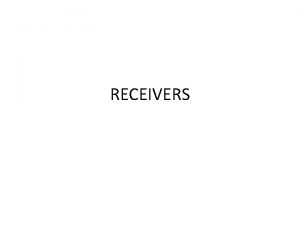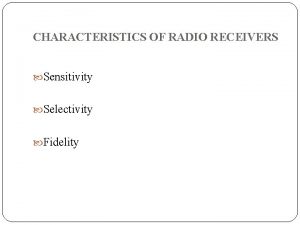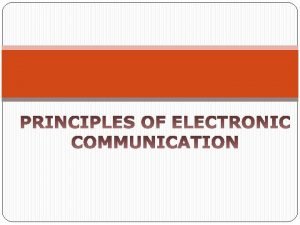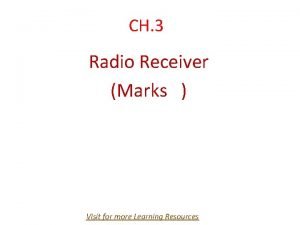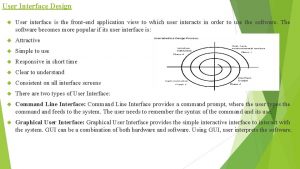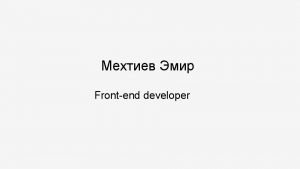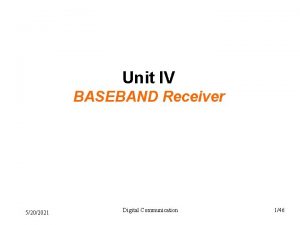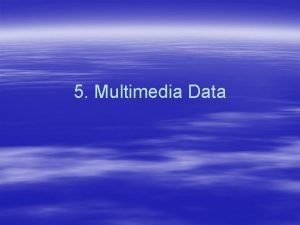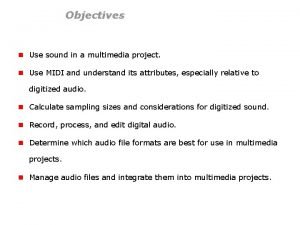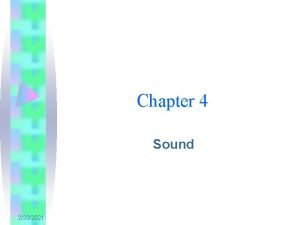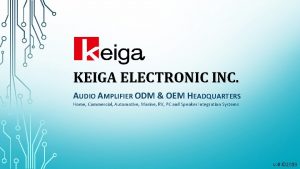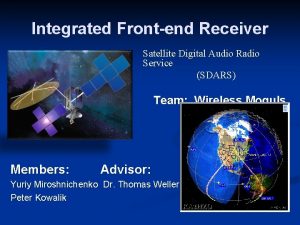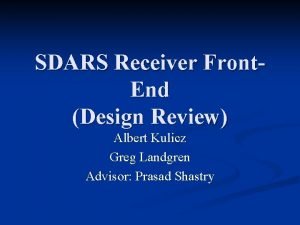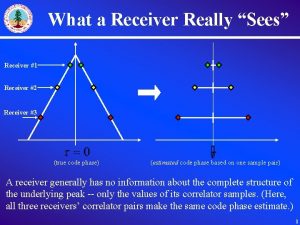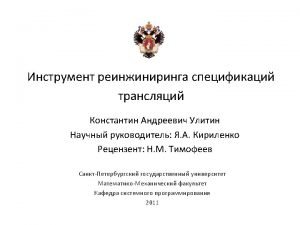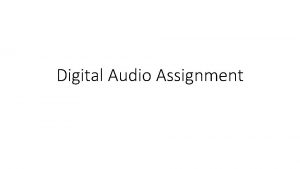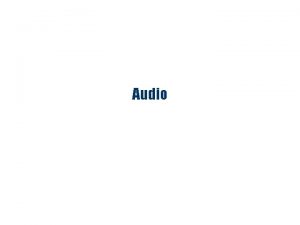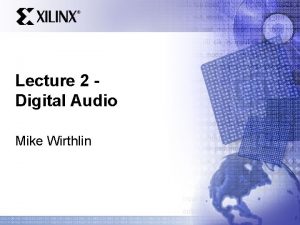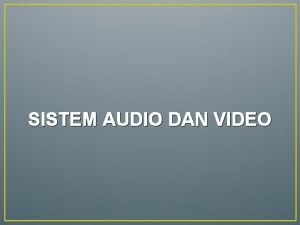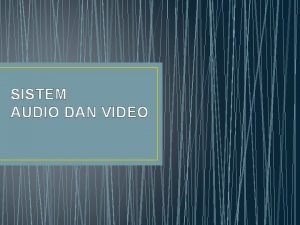Satellite Digital Audio Radio Service Receiver FrontEnd SDARS


















- Slides: 18

Satellite Digital Audio Radio Service Receiver Front-End (SDARS) Albert Kulicz Greg Landgren Advisor: Dr. Prasad Shastry

SDARS What is SDARS n Overall System Block Diagram n Patch Antenna n Low Noise Amplifiers (LNA) n Equipment and Parts List n Tasks for Next Semester n

What is SDARS? n n n The Satellite Digital Audio Radio Service is primarily for entertainment broadcasting from orbital satellites and received by modules commonly found on modern automobiles. (ex: XM or Sirius Radio) This project involves designs, simulations, fabrication, and testing of a patch antenna and lownoise amplifier (LNA) to receive SDARS signals by means of SIRIUS receiver. The inclusion of the entire active antenna (passive antenna + impedance matching network + LNA) will be designed to minimize physical size, while producing the best quality of signal.

System Block Diagram Incoming Circularly Polarized Satellite Signal (-105 to -95)dbm

Antenna and LNA physical board design n Compared to past SDARS projects, our design will contain the entire active antenna on a single “board” consisting of two substrates as seen below.

Patch Antenna Passive portion of the active antenna n Receives incoming signal from satellite n Design Goal – Make it smaller than previous SDARS attempts and stay within the specified requirements n

Antenna Requirements Receive signals in the frequency band from 2. 32 GHz to 2. 3325 GHz (BW of 12. 5 MHz) n Left Hand Circular Polarization (LHCP) n Match in impedance to LNA network (~50 Ohms) Probe Feed – Placement will determine polarization and impedance match n

Antenna Requirements Cont… Desired: VSWR <2 or S 11<-10 d. B , fo = 2. 326 GHz , 12. 5 MHz BW

Antenna Impedance Bandwidth . 012 %BW = BW/fo = (12. 5 M Hz/2. 326 GHz) * 100% = 0. 537%

Antenna High Frequency Substrate - Rogers RO 3003

Antenna Dimension Equations (L=W for square patch) n Initial length L = c/(2 fo* εr^(1/2)) εeff= (εr+1)/2 + (εr-1)/2*[1+12(h/L))^(-1/2) n Fringe factor, ΔL=0. 412 h (ε eff + 0. 3)( W/h + 0. 264) / ( (ε eff - 0. 258)(W/h + 0. 8)) n New length L = c/(2 fo* εeff^(1/2)) - 2ΔL n repeat iterative process 3. 692 cm x 3. 692 cm [1] Balanis, Constantine A, “Microstrip Antennas, ” in Antenna Theory, 3 rd ed. John Wiley and Sons, Inc. , 2005, pp. 811 -882

LHCP and Probe Feed n SDARS signal from satellite is LHCP so the antenna must also be LHCP to receive the signal LHCP Probe Feed on Patch Antenna n Using CPPATCH program we determined the distance from the center to edge (along diagonal) to be 0. 382 cm

Low Noise Amplifers (LNA) The LNA network will take the low-power satellite signal and amplify it to a level where the Sirius receiver can reliably decode the radio channels n A cascaded network of LNAs will allow us to achieve both a low total noise factor and a high total gain n Two stages of amplification will suffice n

LNA Requirements n Noise factor shall be <= 1 d. B NF = F 1 + (F 2 -1)/G 1 + (F 3 -1)/(G 1*G 2 )+. . . n Total gain shall be -> 40~50 d. B Gtotal = G 1 + G 2 +. . .

Hittite LNAs First stage NF <. 9 d. B Second stage Higher Gain Total Noise Factor = 0. 77 Total Gain = 45 d. B

Parts and Equipment n n n RO 3003 substrate Sirius Radio Receiver LNA substrate tbd HMC 548 LP 3 LNA HMC 667 LP 2 LNA MCL 15542 DC Blocking Capacitor § EM Simulation Software (Sonnet / Momentum) § PCAAD § Agilent ADS § CPPATCH § Network Analyzer § Spectrum Analyzer § Frequency Generator § Power Supplies

Tasks for Next Semester n Complete EM simulations with Sonnet and n n n n Momentum and optimize antenna design (Feb) Test LNA evaluation boards with NA (Feb) Design Impedance Matching for the LNA network (Feb) Design Bias Circuitry for the LNAs (March) Simulate entire active antenna in Agilent ADS (March) Outsource Fabrication of Substrates (March) Test Fabricated Antenna and LNA Substrates (April) Test complete system active antenna board with

QUESTIONS ? ? ?
 Sdars
Sdars Dth architecture
Dth architecture Digital rf receivers equipment
Digital rf receivers equipment Selectivity and sensitivity of receiver
Selectivity and sensitivity of receiver What are the characteristics of radio receiver
What are the characteristics of radio receiver Double spotting in superheterodyne receivers is caused by
Double spotting in superheterodyne receivers is caused by Connevans roger pen
Connevans roger pen Front end of compiler
Front end of compiler How many groups of golden rules are coined by theo mandel
How many groups of golden rules are coined by theo mandel Frontend optimization
Frontend optimization Api frontend backend
Api frontend backend Flexbox vs bootstrap
Flexbox vs bootstrap Baseband receiver in digital communication
Baseband receiver in digital communication Conventional radio system
Conventional radio system Audio data representation
Audio data representation Sound editing operations in multimedia
Sound editing operations in multimedia Vaughan's law of multimedia minimums
Vaughan's law of multimedia minimums Oem digital audio amplifier
Oem digital audio amplifier Definisi multimedia
Definisi multimedia


